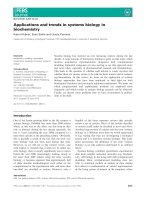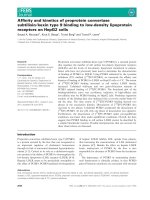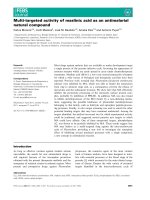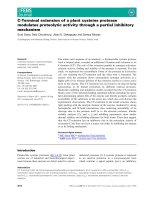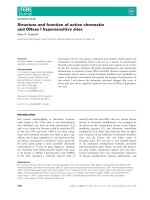Tài liệu Báo cáo khoa học: "K-means Clustering with Feature Hashing" docx
Bạn đang xem bản rút gọn của tài liệu. Xem và tải ngay bản đầy đủ của tài liệu tại đây (168.61 KB, 5 trang )
Proceedings of the ACL-HLT 2011 Student Session, pages 122–126,
Portland, OR, USA 19-24 June 2011.
c
2011 Association for Computational Linguistics
K-means Clustering with Feature Hashing
Hajime Senuma
Department of Computer Science
University of Tokyo
7-3-1 Hongo, Bunkyo-ku, Tokyo 113-0033, Japan
Abstract
One of the major problems of K-means is
that one must use dense vectors for its cen-
troids, and therefore it is infeasible to store
such huge vectors in memory when the feature
space is high-dimensional. We address this is-
sue by using feature hashing (Weinberger et
al., 2009), a dimension-reduction technique,
which can reduce the size of dense vectors
while retaining sparsity of sparse vectors. Our
analysis gives theoretical motivation and jus-
tification for applying feature hashing to K-
means, by showing how much will the objec-
tive of K-means be (additively) distorted. Fur-
thermore, to empirically verify our method,
we experimented on a document clustering
task.
1 Introduction
In natural language processing (NLP) and text min-
ing, clustering methods are crucial for various tasks
such as document clustering. Among them, K-
means (MacQueen, 1967; Lloyd, 1982) is “the most
important flat clustering algorithm” (Manning et al.,
2008) both for its simplicity and performance.
One of the major problems of K-means is that it
has K centroids which are dense vectors where K
is the number of clusters. Thus, it is infeasible to
store them in memory and slow to compute if the di-
mension of inputs is huge, as is often the case with
NLP and text mining tasks. A well-known heuris-
tic is truncating after the most significant features
(Manning et al., 2008), but it is difficult to analyze
its effect and to determine which features are signif-
icant.
Recently, Weinberger et al. (2009) introduced fea-
ture hashing, a simple yet effective and analyzable
dimension-reduction technique for large-scale mul-
titask learning. The idea is to combine features
which have the same hash value. For example, given
a hash function h and a vector x, if h(1012) =
h(41234) = 42, we make a new vector y by set-
ting y
42
= x
1012
+ x
41234
(or equally possibly
x
1012
−x
41234
, −x
1012
+x
41234
, or −x
1012
−x
41234
).
This trick greatly reduces the size of dense vec-
tors, since the maximum index value becomes
equivalent to the maximum hash value of h. Further-
more, unlike random projection (Achlioptas, 2003;
Boutsidis et al., 2010), feature hashing retains spar-
sity of sparse input vectors. An additional useful
trait for NLP tasks is that it can save much memory
by eliminating an alphabet storage (see the prelim-
inaries for detail). The authors also justified their
method by showing that with feature hashing, dot-
product is unbiased, and the length of each vector
is well-preserved with high probability under some
conditions.
Plausibly this technique is useful also for clus-
tering methods such as K-means. In this paper, to
motivate applying feature hashing to K-means, we
show the residual sum of squares, the objective of
K-means, is well-preserved under feature hashing.
We also demonstrate an experiment on document
clustering and see the feature size can be shrunk into
3.5% of the original in this case.
122
2 Preliminaries
2.1 Notation
In this paper, || · || denotes the Euclidean norm, and
·, · does the dot product. δ
i,j
is the Kronecker’s
delta, that is, δ
i,j
= 1 if i = j and 0 otherwise.
2.2 K-means
Although we do not describe the famous algorithm
of K-means (MacQueen, 1967; Lloyd, 1982) here,
we remind the reader of its overall objective for
later analysis. If we want to group input vec-
tors into K clusters, K-means can surely output
clusters ω
1
, ω
K
and their corresponding vectors
µ
1
, , µ
K
such that they locally minimize the resid-
ual sum of squares (RSS) which is defined as
K
k=1
x∈ω
k
||x − µ
k
||
2
.
In the algorithm, µ
k
is made into the mean of the
vectors in a cluster ω
k
. Hence comes the name K-
means.
Note that RSS can be regarded as a metric since
the sum of each metric (in this case, squared Eu-
clidean distance) becomes also a metric by con-
structing a 1-norm product metric.
2.3 Additive distortion
Suppose one wants to embed a metric space (X, d)
into another one (X
, d
) by a mapping φ. Its ad-
ditive distortion is the infimum of which, for any
observed x, y ∈ X, satisfies the following condition:
d(x, y) − ≤ d
(φ(x), φ(y)) ≤ d(x, y) + .
2.4 Hashing tricks
According to an account by John Langford
1
, a
co-author of papers on feature hashing (Shi et al.,
2009; Weinberger et al., 2009), hashing tricks for
dimension-reduction were implemented in various
machine learning libraries including Vowpal Wab-
bit, which he realesed in 2007.
Ganchev and Dredze (2008) named their hashing
trick random feature mixing and empirically sup-
ported it by experimenting on NLP tasks. It is simi-
lar to feature hashing except lacking of a binary hash
1
/>˜
jl/projects/hash_
reps/index.html
function. The paper also showed that hashing tricks
are useful to eliminate alphabet storage.
Shi et al. (2009) suggested hash kernel, that is,
dot product on a hashed space. They conducted thor-
ough research both theoretically and experimentally,
extending this technique to classification of graphs
and multi-class classification. Although they tested
K-means in an experiment, it was used for classifi-
cation but not for clustering.
Weinberger et al. (2009)
2
introduced a technique
feature hashing (a function itself is called the hashed
feature map), which incorporates a binary hash func-
tion into hashing tricks in order to guarantee the hash
kernel is unbiased. They also showed applications
to various real-world applications such as multitask
learning and collaborative filtering. Though their
proof for exponential tail bounds in the original pa-
per was refuted later, they reproved it under some
extra conditions in the latest version. Below is the
definition.
Definition 2.1. Let S be a set of hashable features,
h be a hash function h : S → {1, , m}, and ξ be
ξ : S → {±1}. The hashed feature map φ
(h,ξ)
:
R
|S|
→ R
m
is a function such that the i-th element
of φ
(h,ξ)
(x) is given by
φ
(h,ξ)
i
(x) =
j:h(j)=i
ξ(j)x
j
.
If h and ξ are clear from the context, we simply
write φ
(h,ξ)
as φ.
As well, a kernel function is defined on a hashed
feature map.
Definition 2.2. The hash kernel ·, ·
φ
is defined as
x, x
φ
= φ(x), φ(x
).
They also proved the following theorem, which
we use in our analysis.
Theorem 2.3. The hash kernel is unbiased, that is,
E
φ
[x, x
φ
] = x, x
.
The variance is
V ar
φ
[x, x
φ
] =
1
m
i=j
x
2
i
x
2
j
+ x
i
x
i
x
j
x
j
.
2
The latest version of this paper is at arXiv http://
arxiv.org/abs/0902.2206, with correction to Theorem
3 in the original paper included in the Proceeding of ICML ’09.
123
2.4.1 Eliminating alphabet storage
In this kind of hashing tricks, an index of inputs
do not have to be an integer but can be any hash-
able value, including a string. Ganchev and Dredze
(2008) argued this property is useful particularly for
implementing NLP applications, since we do not
anymore need an alphabet, a dictionary which maps
features to parameters.
Let us explain in detail. In NLP, features can be
often expediently expressed with strings. For in-
stance, a feature ‘the current word ends with -ing’
can be expressed as a string cur:end:ing (here
we suppose : is a control character). Since indices
of dense vectors (which may be implemented with
arrays) must be integers, traditionally we need a dic-
tionary to map these strings to integers, which may
waste much memory. Feature hashing removes this
memory waste by converting strings to integers with
on-the-fly computation.
3 Method
For dimension-reduction to K-means, we propose
a new method hashed K-means. Suppose you have
N input vectors x
1
, , x
N
. Given a hashed fea-
ture map φ, hashed K-means runs K-means on
φ(x
1
), , φ(x
N
) instead of the original ones.
4 Analysis
In this section, we show clusters obtained by the
hashed K-means are also good clusters in the orig-
inal space with high probability. While Weinberger
et al. (2009) proved a theorem on (multiplicative)
distortion for Euclidean distance under some tight
conditions, we illustrate (additive) distortion for
RSS. Since K-means is a process which monoton-
ically decreases RSS in each step, if RSS is not dis-
torted so much by feature hashing, we can expect
results to be reliable to some extent.
Let us define the difference of the residual sum of
squares (DRSS).
Definition 4.1. Let ω
1
, ω
K
be clusters, µ
1
, , µ
K
be their corresponding centroids in the original
space, φ be a hashed feature map, and µ
φ
1
, , µ
φ
K
be
their corresponding centroids in the hashed space.
Then, DRSS is defined as follows:
DRSS = |
K
k=1
x∈ω
k
||φ(x) − µ
φ
k
||
2
−
K
k=1
x∈ω
k
||x − µ
k
||
2
|.
Before analysis, we define a notation for the (Eu-
clidean) length under a hashed space:
Definition 4.2. The hash length ||· ||
φ
is defined as
||x||
φ
= ||φ(x)||
=
φ(x), φ(x) =
x, x
φ
.
Note that it is clear from Theorem 2.3 that
E
φ
[||x||
2
φ
] = ||x||
2
, and equivalently E
φ
[||x||
2
φ
−
||x||
2
] = 0.
In order to show distortion, we want to use Cheby-
shev’s inequality. To this end, it is vital to know the
expectation and variance of the sum of squared hash
lengths. Because the variance of the sum of ran-
dom variables derives from each covariance between
pairs of variables, first we show the covariance be-
tween the squared hash length of two vectors.
Lemma 4.3. The covariance between the squared
hash length of two vectors x, y ∈ R
n
is
Cov
φ
(||x||
2
φ
, ||y||
2
φ
) =
ψ(x, y)
m
,
where
ψ(x, y) = 2
i=j
x
i
x
j
y
i
y
j
.
This lemma can be proven by the same technique
described in the Appendix A of Weinberger et al.
(2009).
Now we see the following lemma.
Lemma 4.4. Suppose we have N vectors
x
1
, , x
N
. Let us define X =
i
||x
i
||
2
φ
−
i
||x
i
||
2
=
i
||x
i
||
2
φ
− ||x
i
||
2
. Then, for any
> 0,
P
|X| ≥
√
m
N
i=1
N
j=1
ψ(x
i
, x
j
)
≤
1
2
.
124
Proof. This is an application of Chebyshev’s in-
equality. Namely, for any > 0,
P
|X −E
φ
[X]| ≥
V ar
φ
[X]
≤
1
2
.
Since the expectation of a sum is the sum of ex-
pectations we readily know the zero expectation:
E
φ
[X] = 0.
Since adding constants to the inputs of covariance
does not change its result, from Lemma 4.3, for any
x, y ∈ R
n
,
Cov
φ
(||x||
2
φ
− ||x||
2
, ||y||
2
φ
− ||y||
2
) =
ψ(x, y)
m
.
Because the variance of the sum of random vari-
ables is the sum of the covariances between every
pair of them,
V ar
φ
[X] =
1
m
N
i=1
N
j=1
ψ(x
i
, x
j
).
Finally, we see the following theorem for additive
distortion.
Theorem 4.5. Let Ψ be the sum of ψ(x, y) for any
observed pair of x, y, each of which expresses the
difference between an example and its correspond-
ing centroid. Then, for any ,
P (|DRSS| ≥ ) ≤
Ψ
2
m
.
Thus, if m ≥ γ
−1
Ψ
−2
where 0 < γ <= 1, with
probability at least 1 −γ, RSS is additively distorted
by .
Proof. Note that a hashed feature map φ
(h,ξ)
is lin-
ear, since φ(x) = Mx with a matrix M such
that M
i,j
= ξ(i)δ
h(i),j
. By this liearlity, µ
φ
k
=
|ω
k
|
−1
x∈ω
k
φ(x) = φ(|ω
k
|
−1
x∈ω
k
x) =
φ(µ
k
). Reapplying linearlity to this result, we have
||φ(x)−µ
φ
k
||
2
= ||x−µ
k
||
2
φ
. Lemma 4.4 completes
the proof.
The existence of Ψ in the theorem suggests that to
use feature hashing, we should remove useless fea-
tures which have high values from data in advance.
For example, if frequencies of words are used as
0.2
0.25
0.3
0.35
0.4
0.45
0.5
0.55
0.6
0.65
0.7
10 100 1000 10000 100000 1e+06
F5 measure
hash size m
hashed k-means
Figure 1: The change of F5-measure along with the hash
size
features, function words should be ignored not only
because they give no information for clustering but
also because their high frequencies magnify distor-
tion.
5 Experiments
To empirically verify our method, from 20 News-
groups, a dataset for document classification or clus-
tering
3
, we chose 6 classes and randomly drew 100
documents for each class.
We used unigrams and bigrams as features and ran
our method for various hash sizes m (Figure 1). The
number of unigrams is 33,017 and bigrams 109,395,
so the feature size in the original space is 142,412.
To measure performance, we used the F
5
mea-
sure (Manning et al., 2008). The scheme counts
correctness pairwisely. For example, if a docu-
ment pair in an output cluster is actually in the
same class, it is counted as true positive. In con-
trast, if it is actually in the different class, it is
counted as false positive. Following this man-
ner, a contingency table can be made as follows:
Same cluster Diff. clusters
Same class TP FN
Diff. classes FP TN
Now, F
β
measure can be defined as
F
β
=
(β
2
+ 1)P R
β
2
P + R
where the precision P = T P/(TP + F P) and the
recall R = T P/(T P + F N).
3
/>125
In short, F
5
measure strongly favors precision to
recall. Manning et al. (2008) stated that in some
cases separating similar documents is more unfavor-
able than putting dissimilar documents together, and
in such cases the F
β
measure (where β > 1) is a
good evaluation criterion.
At the first look, it seems odd that performance
can be higher than the original where m is low. A
possible hypothesis is that since K-means only lo-
cally minimizes RSS but in general there are many
local minima which are far from the global optimal
point, therefore distortion can be sometimes useful
to escape from a bad local minimum and reach a
better one. As a rule, however, large distortion kills
clustering performance as shown in the figure.
Although clustering is heavily case-dependent, in
this experiment, the resulting clusters are still reli-
able where the hash size is 3.5% of the original fea-
ture space size (around 5,000).
6 Future Work
Arthur and Vassilvitskii (2007) proposed K-
means++, an improved version of K-means which
guarantees its RSS is upper-bounded. Combining
their method and the feature hashing as shown in our
paper will produce a new efficient method (possibly
it can be named hashed K-means++). We will ana-
lyze and experiment with this method in the future.
7 Conclusion
In this paper, we argued that applying feature hash-
ing to K-means is beneficial for memory-efficiency.
Our analysis theoretically motivated this combina-
tion. We supported our argument and analysis by
an experiment on document clustering, showing we
could safely shrink memory-usage into 3.5% of the
original in our case. In the future, we will analyze
the technique on other learning methods such as K-
means++ and experiment on various real-data NLP
tasks.
Acknowledgements
We are indebted to our supervisors, Jun’ichi Tsujii
and Takuya Matsuzaki. We are also grateful to the
anonymous reviewers for their helpful and thought-
ful comments.
References
Dimitris Achlioptas. 2003. Database-friendly random
projections: Johnson-Lindenstrauss with binary coins.
Journal of Computer and System Sciences, 66(4):671–
687, June.
David Arthur and Sergei Vassilvitskii. 2007. k-means++
: The Advantages of Careful Seeding. In Proceedings
of the Eighteenth Annual ACM-SIAM Symposium on
Discrete Algorithms, pages 1027–1035.
Christos Boutsidis, Anastasios Zouzias, and Petros
Drineas. 2010. Random Projections for k-means
Clustering. In Advances in Neural Information Pro-
cessing Systems 23, number iii, pages 298–306.
Kuzman Ganchev and Mark Dredze. 2008. Small Statis-
tical Models by Random Feature Mixing. In Proceed-
ings of the ACL08 HLT Workshop on Mobile Language
Processing, pages 19–20.
Stuart P. Lloyd. 1982. Least Squares Quantization in
PCM. IEEE Transactions on Information Theory,
28(2):129–137.
J MacQueen. 1967. Some Methods for Classification
and Analysis of Multivariate Observations. In Pro-
ceedings of 5th Berkeley Symposium on Mathematical
Statistics and Probability, pages 281–297.
Christopher D. Manning, Prabhakar Raghavan, and Hin-
rich Sch
¨
utze. 2008. Introduction to Information Re-
trieval. Cambridge University Press.
Qinfeng Shi, James Petterson, Gideon Dror, John Lang-
ford, Alex Smola, and S.V.N. Vishwanathan. 2009.
Hash Kernels for Structured Data. Journal of Machine
Learning Research, 10:2615–2637.
Kilian Weinberger, Anirban Dasgupta, John Langford,
Alex Smola, and Josh Attenberg. 2009. Feature Hash-
ing for Large Scale Multitask Learning. In Proceed-
ings of the 26th International Conference on Machine
Learning.
126


